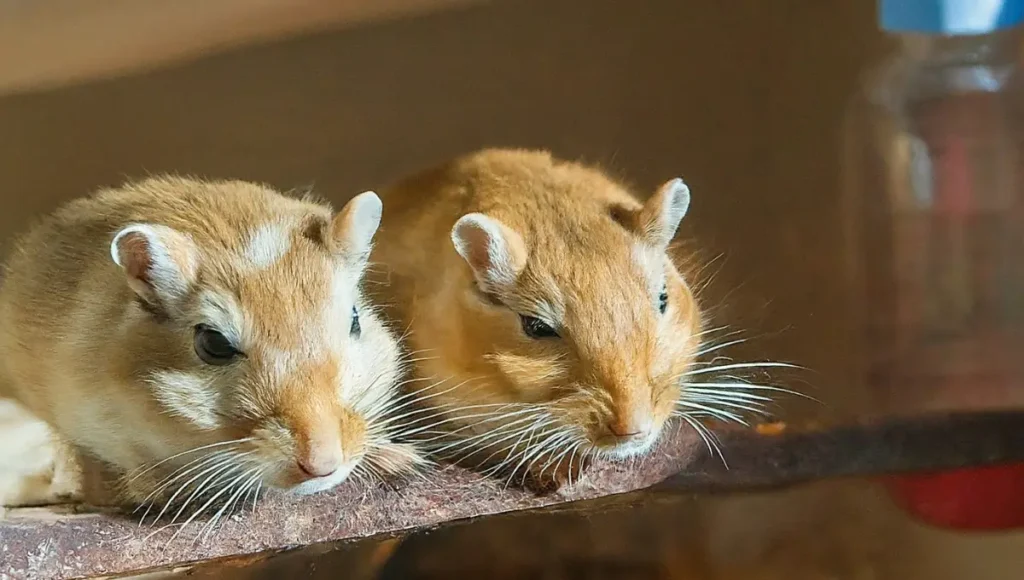Gerbils are fascinating creatures, known for their playful nature and social behavior. As small as they are, these rodents carry a big heart, making them perfect companions for both young and old pet enthusiasts.
However, before diving into the world of gerbil ownership, it’s crucial to understand their social needs and how many gerbils can live in a single cage.
Gerbil Social Structure: Understanding the Basics
Gerbils are inherently social animals, thriving on companionship and interaction. Originating from the deserts of Mongolia, these creatures are accustomed to living in groups, which in the wild, can consist of up to 15 members.
This social hierarchy is not just about cohabitation; it’s about forming bonds, grooming each other, and engaging in playful wrestling. Such activities are not merely pastimes but are essential for their mental and physical well-being.
The concept of declanning, or the breakdown of these social groups, is a critical aspect of gerbil social dynamics. It occurs when the harmony within the group is disturbed, leading to aggression and isolation of members.
This phenomenon is more common in captivity, where space and escape routes are limited. Understanding the delicate balance of gerbil social structure is key to preventing declanning and ensuring a peaceful coexistence.
How Many Gerbils Can Live Together?
When it comes to determining how many gerbils can live together harmoniously, the magic numbers are two and three, although with caution.
Pairing Gerbils: The Safest Option
A pair of gerbils, either two males or two females, is considered the safest and most stable option for pet owners. Gerbils form strong bonds with their cage mates, especially when they are siblings or have been introduced at a young age.
The process of bonding pairs, known as the split cage method, is crucial for a harmonious relationship. However, introducing adult gerbils who are strangers to each other can lead to territorial disputes and stress.
Trios and Their Dynamics
While a trio of gerbils can also live together peacefully, the dynamics are slightly more complicated than pairs. The risk of declanning is higher in trios, primarily because the power balance is more challenging to maintain.
If the gerbils are siblings, raised together from birth, the chances of successful cohabitation increase. However, introducing a new member to an established pair is not advisable, as it often leads to aggression and potential declanning.
Larger Groups: When More Is Not Merrier
Although gerbils live in large groups in the wild, replicating this in captivity comes with its set of challenges. The larger the group, the higher the risk of declanning and aggression, as disputes over dominance become more frequent.
Experienced gerbil owners might manage to keep larger groups together by providing ample space and closely monitoring the group dynamics. However, for most, sticking to pairs or trios is recommended to ensure the well-being of these social creatures.
Housing Considerations: Creating a Comfortable Home for Your Gerbils

When planning to bring gerbils into your home, understanding their housing needs is as crucial as knowing how many can live together. A well-thought-out gerbilarium not only supports their social structure but also promotes their overall well-being.
Cage Size and Space Requirements
The size of the cage is a pivotal factor in ensuring a harmonious living environment for gerbils. The general rule of thumb is to provide at least 10 gallons of space for the first gerbil and an additional 5 gallons for each subsequent gerbil.
This means a pair of gerbils would require a minimum of a 15-gallon tank, but more space is always better. A spacious cage prevents stress and aggression, giving each gerbil enough room to explore, play, and have a space of its own.
Environmental Enrichment: More Than Just Space
A gerbil’s cage should be more than just a living space; it should be a stimulating environment that mimics their natural habitat. This includes tunnels, nesting areas, and plenty of digging opportunities. Toys and exercise wheels can also help keep your gerbils physically active and mentally engaged.
Remember, a stimulated gerbil is a happy gerbil. Regularly changing the layout of the cage and introducing new toys can help prevent boredom and encourage natural behaviors like foraging and burrowing.
Special Considerations: Ensuring Peace Amongst Your Gerbils
Even with the perfect group size and a well-equipped cage, there are special considerations every gerbil owner should be aware of to maintain harmony and prevent common issues.
Mixed-Gender Groups and Breeding Control
While it might be tempting to keep male and female gerbils together for their companionship, this inevitably leads to breeding. Unless you’re prepared for the responsibility of baby gerbils, it’s best to stick to same-sex groups. If you accidentally end up with a mixed-gender group, consider neutering the male to prevent unwanted litters.
Handling Declanning and Aggression
Regardless of your best attempts, declanning and hostility can still happen. It’s essential to monitor your gerbils for signs of stress or fighting and be prepared to intervene. This might mean separating the aggressor from the group or reconfiguring your gerbil pairs. Always have a spare cage on hand for such situations.
FAQs
Can a Single Gerbil Live Happily Alone?
Gerbils are inherently social creatures and thrive in the company of their kind. A single gerbil can quickly become lonely and depressed, leading to health issues. If you find yourself with a lone gerbil, consider introducing a new companion using the split cage method.
How to Know if Gerbils Are Fighting or Playing?
Gerbils play wrestle, which is normal and healthy. However, if you notice persistent chasing, biting that leads to injuries, or one gerbil constantly hiding, these could be signs of aggression. In such cases, it’s crucial to separate the gerbils to prevent harm.
What to Do if Gerbils Declan?
If your gerbils declan, or if you notice signs of serious aggression, separate them immediately into different cages. Consult with a vet or an experienced gerbil breeder on the best course of action, which may include reintroduction attempts after a cooling-off period.
Conclusion
In conclusion, understanding the social dynamics, housing needs, and special considerations for gerbils is essential for any pet owner looking to create a harmonious living environment for these delightful creatures.
By carefully considering the number of gerbils, providing ample space, and enriching their habitat, you can foster a healthy and happy life for your gerbil companions.
Remember, the key to successful gerbil care lies in meeting their complex needs and being vigilant about their social interactions. With the right approach, your gerbils will thrive, bringing joy and activity to your home.











